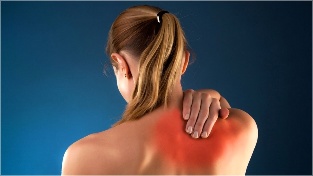Symptoms of osteochondrosis in the cervical spine and home treatment are based on the method of self-healing. The method consists of correct actions of the patient and support of the functions of self-regulation, self-healing of the body to restore nervous and vascular disorders in the cervical spine.

In non-advanced and non-severe cases, the patient can naturally relieve back pain, muscle spasm, dizziness and other symptoms of cervical osteochondrosis in a natural, drug-free manner. However, for this it is necessary to know well the natural structure and purpose of the spine and to remember that our body is a self-healing system that exists according to certain laws of the Universe.
Role of the Spine
Before considering the topic: "Osteochondrosis of the cervical spine, symptoms and treatment at home", it is logical to dwell on the question: "What role does the spine play in our lives? "
The backbone is the skeleton of our skeleton. The head, trunk, upper and lower limbs rest on it. In other words, it is the spine that gives our body the shape we usually see.
Attached to the spine are the strong connective tissue ligaments and many large and small muscles that hold our body in place, and the vital internal organs in certain places along the spine.The normal functions of our internal organs and all tissues of the body are provided by a large number of nerve fibers through the transmission of nerve impulses from the lateral parts of the spinal cord.
The spinal cord is located in a well-protected, flexible "coil" of the spinal canal from external influences. Through the intervertebral foramen of the vertebrae, the roots of the spinal nerve emerge. In the initial part, they are covered with discs and bone structures. The intervertebral discs consist of cartilaginous plates located above and below, a fibrosus anulus and a nucleus pulposus. The thickness of the discs in the cervical vertebrae is very small - only 4 mm.Causes of cervical osteochondrosis
Healthy and intact intervertebral discs serve as shock absorbers for various loads on the spine (compression, stretching). If, as a result of sudden movements, excessive exertion, incorrect prolonged posture, spinal cord injuries or inflammatory processes, the discs are damaged, the vertebral artery is constricted, which passes through the openings of the vertebrae and nerve plexuses emerging from the marrowspinal.
The number of electrical impulses going from the spinal cord to organs and tissues decreases, metabolic processes slow down. This becomes the cause of disease of certain organs as well as the cause of aging of the body.
Symptoms
This explains the many symptoms of osteochondrosis of the cervical spine, which include pain in the neck, back of the head, shoulder girdle, heart, liver and stiff neck, back of the head, weakness of thearms, legs and vascular disorders.
The onset of the disease depends on the location of the disc damage and the displacement of the vertebrae, as well as the area innervated by the compressed nerve plexus.So the health of our body depends on the health of the spine.
Self-healing treatment
I just want to warn you that the diagnosis of cervical osteochondrosis is made by a neurologist or chiropractor based on the results of a comprehensive medical examination.
When the diagnosis is made and there is no acute period of swelling and inflammation at the site of intervertebral disc injury, a self-healing method may be applied.
The essence of the method:
- in the correct actions of the patient, aimed at eliminating the cause of the symptoms of osteochondrosis - compression, displacement of nerve and vascular structures of the spinal cord in connection with the destructive changes in the intervertebral discs;
- in support of the body's self-regulating, self-healing functions to restore nervous and vascular disorders in the cervical spine.
How to treat osteochondrosis of the cervical spine, acting independently on the cause of the disease, you can read in the article of the same name.
it is impossible to eliminate the cause of the disease - deformity of the intervertebral discs, however, you can learn to relax the cervical spine and gently stretch the cervical vertebrae to relieve pressure on the nerve roots and blood vessels, thus relieving the symptoms of compression.
The self-healing method requires personal desire, perseverance, self-discipline and a willingness to gradually change your posture, take good care of your spine, relax and stretch your neck every morning and evening and develop your own treatment systemof cervical osteochondrosis.
At the same time, always remember that your body is a highly organized self-healing system that lives by the laws of nature. Failures in it occur when you violate these laws, no matter why, due to ignorance of them, or unwillingness to abide by them.
Principles of the Method
Before proceeding with the self-healing method with the help of therapeutic exercises, some natural principles of this method should be noted.
- It is known that in order for a muscle to relax well, you must first tense it. Therefore, many of the therapeutic exercises developed by manual therapy specialists are based on the principle of tension - relaxation of spasmodic muscles.
- Another principle is the physiological model of the combination of tension - muscle relaxation with the phases of respiration. Inhalation is tension, and breathing is relaxation. If these principles are observed, the exercises performed will contribute to the proper functioning of the circulatory system, and will not disrupt the regulation of nervous processes.
Personal self-healing system
First, I will share my self-healing system for cervical osteochondrosis.
In addition to "turtle" exercises and relaxation of the shoulder girdle, sitting ("How to treat osteochondrosis of the cervical spine"), which not only relaxes the muscles in the neck and shoulders, but also awakens the healing powers of the body, by normalizing the power supply of all cells and organs, I use one more position - relaxation of the neck muscles.
However, I want to warn you to be careful when doing this pose! Remember - in the back of the cervix are the vertebral artery and the nerve plexuses that go to the brain!
Since in my case the cervical vertebrae 5, 6 and 7 are deformed, in case of pain and tension in the neck, as well as headache, ringing in the ears, I direct the following pose:
- I lie on my back, on the bed with my head towards the end of my leg (which is without my back). I slowly lower my head down as I exhale so that my seventh cervical vertebra is located on the edge of the mattress. Thus, my head hangs down its weight, my neck bends and relaxes, my chin is raised. This hanging head position should be short - just a few seconds from 5 to 10.
Feeling embarrassed or counting to 10, I slowly begin to "crawl" into bed as I suck, without lifting the back of my head from the bed, holding on to the edges of his head.
You should not suddenly raise your head from such a "hanging" position!
Just a slow "crawl" of the head in bed and stretching the neck at the same time relieves constricted blood vessels and nerves, relieves pain in the neck and head.
After this position, you should lie down in a relaxed state for a few minutes.
This extension of the cervical vertebrae helps to deform the lower vertebrae of the cervix.
Relieve headaches and other symptoms
If the symptoms are dominated by a headache that appears severe in half of the head, sometimes with nausea, this indicates a disturbance in the articulation of the skull with the first cervical vertebra at the exit site of the occipital nerve irritating half ofhead on each side. Therefore, when the occipital nerve is pressed to one side, there is pain on this particular side of the head.
Cardiovascular and respiratory disorders in the background of headache are observed due to the violation of nerve fibers derived from the spinal cord of the second cervical vertebra in the brain flow.
In cases of disorders in the region of the first and second vertebrae, therapeutic approaches to muscle relaxation are also effective. Doctor of Medical Sciences, Professor, Honorary Doctor of the Russian Federation Anatoly Boleslavovich Sitel in his book "Solo for the back" suggests the following position for the relief of headaches.
- Sit in a relaxed chair. But at the same time, keep the bust straight. Tilt your head forward by exhaling so that it "hangs" under the influence of its weight. So hold your head for about 10 seconds. Then, while inhaling, freeze it and rest for half a minute. Repeat the exercise 10 times.
Gentle exercise
With cervical osteochondrosis, symptoms and home treatment, you can use the following two gentle exercises to relax the cervical muscles in case of spasm and pain.
You have to sit in a chair, straighten your trunk. Put your hands on your knees. The legs are parallel to each other. The pose is relaxed, the breathing is calm.
Inhale and lower your head, touch your sternum with your chin, and pull your back up. Hold for a few seconds in this position. Then pull out slowly, raising your head and shoulders. Do 5-7 of these therapeutic exercises.
The starting position for the second exercise is the same as the first. From a sitting position, lie with your body on your feet, head on your knees. As you inhale, slowly raise your head, as you exhale, lower it. Repeat 5-7 times.
During exercise, the neck muscles first tense, then relax more easily and quickly.
All exercises should be performed slowly and smoothly, that is, you should not make sudden movements, you should not rush, you should not experience tension or severe pain. Once you feel comfortable, stop exercising and try to relax and unwind.
Local remedies

At home, in addition to therapeutic exercises to relax and stretch the cervical vertebrae, you can eliminate tension and mild neck pain with manual massage or with the help of massages (after consulting a doctor), as well as day tools - thermal procedures (tinctures, rubbing, compresses, baths).
However, it is important to know that thermal procedures can be harmful in case of severe pain and inflammation in the affected area of the back, as they increase arterial blood flow and slow venous outflow, therefore, they cause deteriorationof symptoms, increase pain and swelling of tissues.For topical application to spasmodic muscles, use the following freshly prepared solution: 15 ml Dimexide, 15 ml solution 0, 5-1% novocaine and 4-6 ml 50% analgin solution are poured into acup where dipping gauze napkins, folded in 4 layers. The size of the napkins should correspond to the painful area.
Wet napkin is placed in the right area (skin is pre-treated with alcohol), covered with cellophane and fixed. The procedure lasts 1-1, 5 hours.
Compresses are made every day for 4-6 days. If redness occurs, it is advisable to replace the Dimexide compress with liniment oil or Dimexide.
Adherence to a proper nutrition diet is very important in the treatment of cervical osteochondrosis.
Prevention
Dear readers, remember that our body is a self-regulating biological system, which, if our behavior is wrong, signals pain or discomfort.
Take care of your spine! Do not jump out of bed! First, roll to your side and, leaning on your elbow, stand up smoothly.
Do not lift weights in front of you and do not carry weights in one hand! It is better to carry the load with a symmetrical load in both hands (for women - no more than 5 kg in each hand, for men - no more than 12 kg in each hand). And you have to lift the load, lower it a bit.
Do not do housework or dacha work, leaning upside down! Washing the floor and plucking the cracks from the beds can be done on the knees or with the help of long tools.

















































